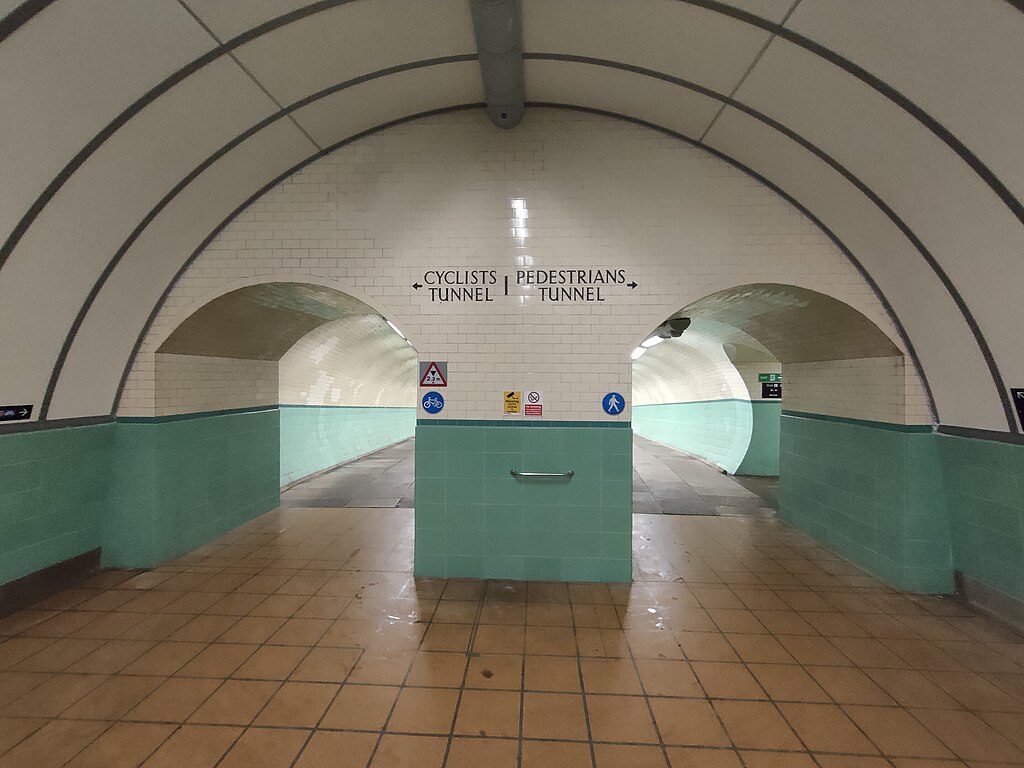The Tyne Cyclist and Pedestrian Tunnel, stands as an iconic piece of infrastructure connecting the banks of the River Tyne in North East England. Its history, engineering, and cultural significance intertwine to create a fascinating narrative of utility and ingenuity.

The tunnel, completed in 1951, was a response to the growing need for a reliable means of transportation between the bustling towns of Jarrow and Howdon. Prior to its construction, the only viable option for crossing the river was via ferry, which proved inefficient, particularly for commuters and cyclists. Thus, the idea for a subterranean passage beneath the river was born.
Designed by engineers John William Dunford and Stuart Lenton, the Tyne Tunnel spans approximately 900 meters, making it one of the longest such tunnels in the United Kingdom. Its construction required the excavation of two large shafts on either bank of the river, which served as entry and exit points for pedestrians and cyclists. The tunnel’s cylindrical shape and reinforced concrete construction were chosen for their durability and ability to withstand the pressure of the river overhead.
Upon its completion, the Tyne Tunnel was hailed as a marvel of modern engineering. Its innovative design allowed for the safe and efficient passage of pedestrians and cyclists beneath the river, free from the constraints of weather and tides. For the first time, residents on both sides of the Tyne had a reliable means of crossing the river, greatly improving connectivity and accessibility for the region.
Beyond its practical utility, the Tyne Tunnel also holds cultural significance for the people of North East England. Over the years, it has become more than just a means of transportation; it is a symbol of community and shared history. Generations of cyclists, pedestrians, and commuters have traversed its dimly lit passageways, each journey adding to the tunnel’s rich tapestry of stories.
In recent years, efforts have been made to modernize the Tyne Tunnel and ensure its continued relevance in the 21st century. Renovations have included upgrades to lighting, ventilation, and safety features, enhancing the overall user experience. Additionally, the tunnel has been integrated into the region’s broader transportation network, with dedicated cycling and walking paths connecting it to surrounding areas.
Despite these advancements, the Tyne Tunnel remains rooted in its past, serving as a tangible link to the region’s industrial heritage. Its walls bear witness to decades of history, from the heyday of shipbuilding to the decline of heavy industry in the latter half of the 20th century. Today, it stands as a testament to the resilience of the communities it serves, a reminder of their ability to adapt and thrive in the face of adversity.
As North East England continues to evolve, the Tyne Cyclist and Pedestrian Tunnel stands as a constant, an enduring symbol of progress and perseverance. Whether it’s commuters making their way to work or families out for a leisurely bike ride, the tunnel remains a vital artery connecting the people and places of the Tyne Valley. And as long as there are cyclists and pedestrians in need of passage across the river, the Tyne Tunnel will endure, a silent sentinel beneath the waters of the Tyne.
Wikipedia
Tyne Cyclist and Pedestrian Tunnel runs under the River Tyne between Howdon and Jarrow in Tyne & Wear, England. Opened in 1951, heralded as a contribution to the Festival of Britain, it was Britain’s first purpose-built cycling tunnel.[1] The original cost was £833,000[1] and the tunnel was used by 20,000 people a day.[2] It consists of two tunnels running in parallel, one for pedestrian use with a 3.2 m (10 ft 6 in) diameter, and a larger 3.7 m (12 ft 2 in) diameter tunnel for pedal cyclists. Both tunnels are 270 m (884 ft) in length, and lie 12 m (40 ft) below the river bed, at their deepest point.[1] The tunnels are over 60 years old and are Grade II listed buildings.[3][2]
At each end, the tunnels are connected to surface buildings by two escalators and a lift. The Waygood-Otis escalators have 306 wooden steps each, and are the original models from 1951.[1] At the time of construction, they were the highest single-rise escalators in the UK, with a vertical rise of 85 feet (26 m) and a length of 197 feet (60 m). In 1992, escalators with a higher vertical rise of 90 feet (27.4 m) and 200 feet (61 m) in length were constructed at Angel station on the London Underground. The Tyne Tunnel escalators remain the longest wooden escalators in the world.

